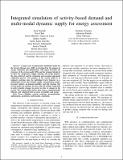| dc.contributor.author | Fournier, Nicholas | |
| dc.contributor.author | Chen, Siyu | |
| dc.contributor.author | Hemerly Viegas de Lima, Isabel | |
| dc.contributor.author | Needell, Zachary Adam | |
| dc.contributor.author | Deliali, Aikaterini | |
| dc.contributor.author | Araldo, AndreaGiuseppe | |
| dc.contributor.author | Akkinepally, Arun | |
| dc.contributor.author | Azevedo, Carlos Lima | |
| dc.contributor.author | Christofa, Eleni | |
| dc.contributor.author | Trancik, Jessika | |
| dc.contributor.author | Ben-Akiva, Moshe E | |
| dc.date.accessioned | 2020-07-13T16:08:35Z | |
| dc.date.available | 2020-07-13T16:08:35Z | |
| dc.date.issued | 2018-12 | |
| dc.date.submitted | 2018-11 | |
| dc.identifier.isbn | 9781728103211 | |
| dc.identifier.isbn | 9781728103235 | |
| dc.identifier.uri | https://hdl.handle.net/1721.1/126152 | |
| dc.description.abstract | The development of a large scale agent-based simulation model for the Greater Boston Area is presented, closing the gap between state-of-the art integrated demand-supply modeling techniques (SimMobility) with advanced energy estimation models (TripEnergy) and shedding light on its practical application to large urban areas. This paper describes the technical details of its three key components (activity-based demand, multi-modal dynamic supply, and trajectory-based energy models), the used data, the model estimation, integration and calibration processes. The proposed model can simulate any day with and without congestion in order to capture changes in energy use across all dimensions of a mobility system, namely temporal, spatial, modal or functional. For an average 24h in the Greater Boston Area the simulated travel of 4.5-million people resulted in 15-million trips and a total vehicle energy consumption of 548 thousand equivalent gallons of gasoline. Our proposed platform allows for the comprehensive and consistent assessment of energy related policies, technologies and services affecting traveler behavior, the transportation system's and vehicle energy performances. | en_US |
| dc.publisher | Institute of Electrical and Electronics Engineers (IEEE) | en_US |
| dc.relation.isversionof | http://dx.doi.org/10.1109/itsc.2018.8569541 | en_US |
| dc.rights | Creative Commons Attribution 4.0 International license | en_US |
| dc.rights.uri | https://creativecommons.org/licenses/by/4.0/ | en_US |
| dc.source | Prof. Ben-Akiva via Phoebe Ayers | en_US |
| dc.title | Integrated simulation of activity-based demand and multi-modal dynamic supply for energy assessment | en_US |
| dc.type | Article | en_US |
| dc.identifier.citation | Fournier, Nicholas et al. "Integrated simulation of activity-based demand and multi-modal dynamic supply for energy assessment." 21st International Conference on Intelligent Transportation Systems (ITSC), November 2018, Maui, HI, USA, Institute of Electrical and Electronics Engineers, December 2018 © 2018 IEEE | en_US |
| dc.contributor.department | Massachusetts Institute of Technology. Department of Civil and Environmental Engineering | en_US |
| dc.relation.journal | 21st International Conference on Intelligent Transportation Systems (ITSC) | en_US |
| dc.eprint.version | Author's final manuscript | en_US |
| dc.type.uri | http://purl.org/eprint/type/ConferencePaper | en_US |
| eprint.status | http://purl.org/eprint/status/NonPeerReviewed | en_US |
| dspace.date.submission | 2020-07-08T17:49:39Z | |
| mit.license | OPEN_ACCESS_POLICY | |
| mit.metadata.status | Complete | |
